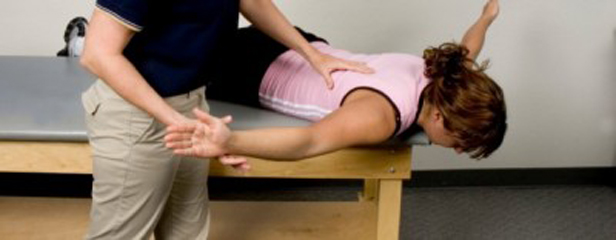
Hi Mike,
First of all, thanks for your article, "The Keys to Upper Body Injury Prevention and Strength." This one solved all of my upper body problems, and I've never felt so healthy and comfortable in this area. Moreover, it put my pressing numbers on the fast lane.
Now for my question. Last week, my orthopedist found a intervertebral disk deterioration between L5 and S1, and he told me to avoid squats and the military press. (I didn't ask for deadlift). This is a big drawback because I train 5/3/1. I am 32 years old and am very interested in a long lasting, pain free future. Thankfully, I am pain free. Only long periods of sitting makes my lower back uncomfortable at times.
Therefore, I have two questions:
1. Is it really necessary to avoid squats and the military press? If yes, what would be alternatives?
2. Which exercises and muscles are best to support an intervertebral disk deterioration?
Best regards from Germany,
Karsten
PS: Most of my research, with respect to powerlifting, supports a herniated vertebral disk, and to my knowledge this must be handled in a different way.
© Hasenonkel | Dreamstime Stock Photos & Stock Free Images
Karsten,
Without knowing your specific injury history and lifting background, it's hard for me to comment specifically to you. However, if I'm working with someone in your condition, radiology reports are only one piece of the discussion. If you aren't having issues when lifting, that's definitely good news.
I would begin by looking at your posture. If you have a large lumbar lordosis (arch) in your back, you need to reduce this. Oftentimes, people with a big lordosis will have the type of pain you describe when sitting/standing for long periods of time. To improve this, work on strengthening the opposing muscle groups: Rectus abdominus, external obliques, glutes, and hamstrings. Perhaps most importantly, work to strengthen the muscles that help you exhale, as this will take stress off your back.
Try this:
- Lay on your back and prop your feet up on a couch or something so that your hips and knees are flexed to 90 degrees.
- From this position, take a breath in and then exhale over the course of 10 seconds.
- Next, hold this exhaled position for another 5 seconds.
- Repeat for 10 breaths.
Do this two to three times a day and let me know how your back feels in a month.
Good luck!
- MR
Mike,
In the last couple of months, I've noticed that my quads seem to be really tight when squatting, to the point where it takes about 180kg on the bar for me to be able to squat to depth without any considerable discomfort. Are there any exercises or movements you'd recommend to help loosen up my quads (ones that I can do both in the gym prior to squatting and possibly at home)?
I have a foam roller at home, but I'm not really too sure on how best to use it to help with tight quads.
- Adam
Adam,
Tight quads/hip flexors are incredibly common in powerlifters. Here are some things I typically prescribe to help them out:
- Static stretching for not just the psoas/iliacus, but for the rectus femoris as well. Any hip flexor stretching should be done while bracing the core.
- If you're in an anterior pelvic tilt, everything you do needs to be geared towards getting out of that position. Extra work for the glutes and hamstrings here are a must.
- The anterior core is crucial. Often, the hip flexors and spinal erectors are doing more than their fair share of the work, so building a strong and STABLE core is crucial.
Try this trick: Before you do your core exercises, try and exhale hard. Doing this will engage the core before you do anything else.
This is a good starting point. Let me know how it goes!
- MR
Hi Mike,
I'm about nine months post-op from a Type II SLAP tear repair, and I'm planning to return to regular lifting again. Some sources say that overhead pressing and overhead pulling are no no's, while others say that it's okay. X-rays reveal that I have plenty of space in my shoulder for the humerus to move around, but I want to be cautious about it. Is there any overhead pressing/pulling that is safe for my shoulder? After some reading, it seems the landmine press may be my best bet, but I'm certainly not the expert. Also, for pulling—perhaps neutral and supinated ring chin-ups? I'll be happy just to be lifting again, but if I could just do some vertical work too, it would be fantastic.
I appreciate your time, and thanks for all the great articles!
- Kurt
Kurt ,
I think you're definitely on the right track here. If I was working with someone in your position, here's the plan of attack I'd give them:
- Start by working to improve upward rotation of the scapulae. Anything that strengthens the upper/lower trapezius and serratus is probably good here. Start with push-ups. There are tons of benefits here including cuff activation, dynamic scapular stability, etc.
- Over time, I'd progress to a push-up to down dog—even more good stuff here, and you start to drive upward rotation of the scap in a closed-chain environment.
- Next, move to the landmine. This will keep you out of true "overhead" motions, but it will still get you more vertical than you'd go with a push-up.
- When you start going overhead, be smart and use a neutral grip. I like single-arm, neutral-grip overhead presses. Enjoy dumbbell/kettlebell variations for a while, and then if it feels good, you can progress back to the barbell with time.
Hopefully that gives you a good starting point. Good luck!
- MR










